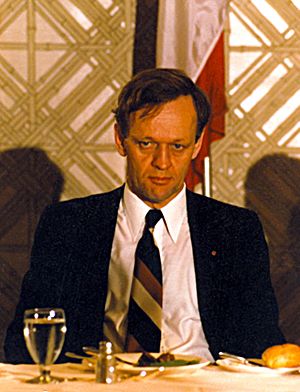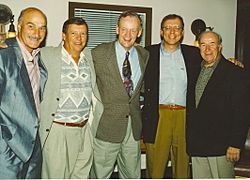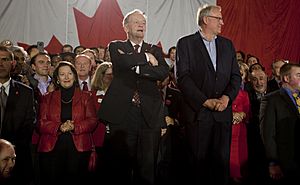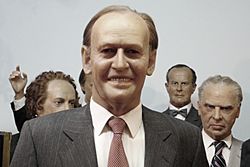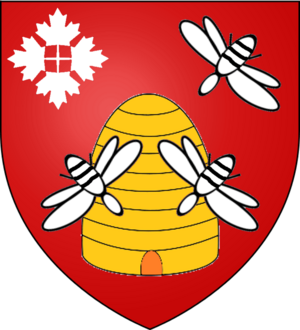Jean Chrétien facts for kids
Quick facts for kids
Jean Chrétien
|
|||||||||||||||||||||||||||||||||||||||||||||||||||||||||||||||||||||||||||||||||||||||||||||||||||||
|---|---|---|---|---|---|---|---|---|---|---|---|---|---|---|---|---|---|---|---|---|---|---|---|---|---|---|---|---|---|---|---|---|---|---|---|---|---|---|---|---|---|---|---|---|---|---|---|---|---|---|---|---|---|---|---|---|---|---|---|---|---|---|---|---|---|---|---|---|---|---|---|---|---|---|---|---|---|---|---|---|---|---|---|---|---|---|---|---|---|---|---|---|---|---|---|---|---|---|---|---|---|
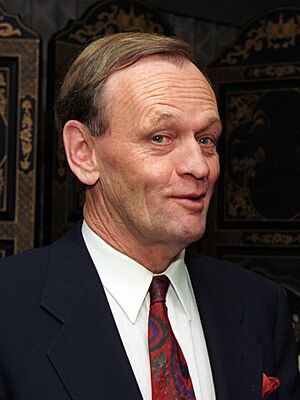
Chrétien in 1993
|
|||||||||||||||||||||||||||||||||||||||||||||||||||||||||||||||||||||||||||||||||||||||||||||||||||||
| 20th Prime Minister of Canada | |||||||||||||||||||||||||||||||||||||||||||||||||||||||||||||||||||||||||||||||||||||||||||||||||||||
| In office November 4, 1993 – December 12, 2003 |
|||||||||||||||||||||||||||||||||||||||||||||||||||||||||||||||||||||||||||||||||||||||||||||||||||||
| Monarch | Elizabeth II | ||||||||||||||||||||||||||||||||||||||||||||||||||||||||||||||||||||||||||||||||||||||||||||||||||||
| Governor General | Ray Hnatyshyn Roméo LeBlanc Adrienne Clarkson |
||||||||||||||||||||||||||||||||||||||||||||||||||||||||||||||||||||||||||||||||||||||||||||||||||||
| Deputy | Sheila Copps Herb Gray John Manley |
||||||||||||||||||||||||||||||||||||||||||||||||||||||||||||||||||||||||||||||||||||||||||||||||||||
| Preceded by | Kim Campbell | ||||||||||||||||||||||||||||||||||||||||||||||||||||||||||||||||||||||||||||||||||||||||||||||||||||
| Succeeded by | Paul Martin | ||||||||||||||||||||||||||||||||||||||||||||||||||||||||||||||||||||||||||||||||||||||||||||||||||||
|
|||||||||||||||||||||||||||||||||||||||||||||||||||||||||||||||||||||||||||||||||||||||||||||||||||||
|
|||||||||||||||||||||||||||||||||||||||||||||||||||||||||||||||||||||||||||||||||||||||||||||||||||||
|
|||||||||||||||||||||||||||||||||||||||||||||||||||||||||||||||||||||||||||||||||||||||||||||||||||||
| Personal details | |||||||||||||||||||||||||||||||||||||||||||||||||||||||||||||||||||||||||||||||||||||||||||||||||||||
| Born |
Joseph Jacques Jean Chrétien
January 11, 1934 Shawinigan Falls, Quebec, Canada |
||||||||||||||||||||||||||||||||||||||||||||||||||||||||||||||||||||||||||||||||||||||||||||||||||||
| Political party | Liberal | ||||||||||||||||||||||||||||||||||||||||||||||||||||||||||||||||||||||||||||||||||||||||||||||||||||
| Spouse | |||||||||||||||||||||||||||||||||||||||||||||||||||||||||||||||||||||||||||||||||||||||||||||||||||||
| Children | 3, including France Chrétien Desmarais | ||||||||||||||||||||||||||||||||||||||||||||||||||||||||||||||||||||||||||||||||||||||||||||||||||||
| Relatives | Michel Chrétien (brother) Raymond Chrétien (nephew) |
||||||||||||||||||||||||||||||||||||||||||||||||||||||||||||||||||||||||||||||||||||||||||||||||||||
| Alma mater | Université Laval | ||||||||||||||||||||||||||||||||||||||||||||||||||||||||||||||||||||||||||||||||||||||||||||||||||||
| Occupation |
|
||||||||||||||||||||||||||||||||||||||||||||||||||||||||||||||||||||||||||||||||||||||||||||||||||||
| Signature | |||||||||||||||||||||||||||||||||||||||||||||||||||||||||||||||||||||||||||||||||||||||||||||||||||||
Jean Chrétien was a Canadian politician and lawyer. He served as the 20th prime minister of Canada from 1993 to 2003. Before that, he was the leader of the Liberal Party of Canada from 1990 to 2003. He also led the Official Opposition in Parliament from 1990 to 1993.
Born in Shawinigan Falls, Quebec, Chrétien studied law at Université Laval. He became a Liberal Member of Parliament in 1963. He held many important jobs in the government under Prime Minister Pierre Trudeau. These roles included Minister of Indian Affairs and Northern Development, President of the Treasury Board, Minister of Finance, and Minister of Justice. As Justice Minister, Chrétien helped bring the Canadian Constitution home to Canada and create the Canadian Charter of Rights and Freedoms.
In 1984, he tried to become the leader of the Liberal Party but lost to John Turner. Chrétien then served as Deputy Prime Minister in Turner's short-lived government. He left politics for a while in 1986. After the Liberals lost another election in 1988, Chrétien returned to politics. He won the party leadership in 1990 and became the leader of the Opposition.
In the 1993 election, Chrétien led the Liberals to a big win, forming a majority government. He won two more majority governments in 1997 and 2000. When he became prime minister, Canada was facing a large national debt. His government worked to cut spending and reform programs. This led to Canada having a budget surplus (more money coming in than going out) in 1997, which was the first time since 1969.
Chrétien strongly opposed the Quebec sovereignty movement (the idea of Quebec becoming its own country). He helped the "No" side win by a small amount in the 1995 Quebec referendum. His government also created the long-gun registry, introduced the harmonized sales tax (HST), and helped with Operation Yellow Ribbon after the September 11 attacks. They also passed laws like the Species At Risk Act and the Youth Criminal Justice Act. His government also prepared the way for legalizing same-sex marriage.
In foreign policy, Chrétien's government signed the Kyoto Protocol on climate change. They also led the way for the Ottawa Treaty to ban landmines. He sent Canadian troops to help in the NATO bombing of Yugoslavia and the War in Afghanistan. However, he chose not to send Canadian troops to the Iraq War.
Chrétien faced some political challenges during his time as prime minister. He was accused of issues related to government spending, but he always said he did nothing wrong. He also had a long-standing rivalry with his finance minister, Paul Martin. In December 2003, Chrétien resigned as prime minister and left politics. He is remembered as one of Canada's important prime ministers.
Contents
- Early Life and Education
- Early Political Career
- In Opposition (1984–1993)
- Prime Minister (1993–2003)
- Retirement
- Legacy
- Supreme Court Appointments
- Honours
- See also
- Succession
Early Life and Education
Jean Chrétien was born on January 11, 1934, in Shawinigan Falls, Quebec. He was the 18th of 19 children in his family. His parents, Marie and Wellie Chrétien, were not wealthy. They wanted their children to get a good education. Jean's father encouraged him to read a lot.
Chrétien's family was strongly Liberal in their political views. This was sometimes difficult in Quebec at the time, as the ruling party, the Union Nationale, was very different. Chrétien went to Catholic schools, which were the only public schools in Quebec until 1964. He later studied law at Université Laval.
As a young man, Chrétien had a condition called Bell's palsy, which caused one side of his face to be partly paralyzed. He used this in his first political campaign, saying he was "One politician who didn't talk out of both sides of his mouth." He is also deaf in one ear.
On September 10, 1957, he married Aline Chaîné. They had three children: France, Hubert, and Michel (who was adopted).
Early Political Career
Chrétien worked as a lawyer before being elected to the House of Commons of Canada in 1963. He represented the area of Saint-Maurice, which included his hometown of Shawinigan. He held this seat for most of the next 41 years.
In 1967, Chrétien became a junior minister in the government. He was appointed Minister of National Revenue in 1968. During the 1968 Liberal leadership race, he supported Pierre Trudeau, who later became prime minister.
Minister of Indian Affairs
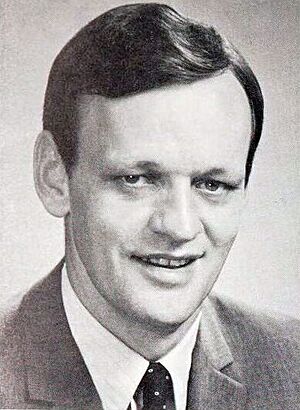
After the 1968 election, Prime Minister Trudeau made Chrétien Minister of Indian Affairs and Northern Development. Chrétien introduced a plan in 1969 to change laws related to treaties with First Nations. This plan was called the "White Paper." Many First Nations groups did not agree with it, saying it would make them lose their unique identity. The plan was later stopped.
During his time as Minister of Indian Affairs, Chrétien became very fond of Canada's far north. He often spent his summers there.
Other Cabinet Roles
In 1974, Chrétien became President of the Treasury Board. In this role, he was known for saying "no" to requests for more money from other government departments. This helped him gain a reputation as a "tough guy" who could make difficult decisions.
From 1976 to 1977, he served as Minister of Industry, Trade and Commerce. He worked to help Canadian businesses trade more with countries in Asia and Europe, rather than relying mostly on the United States.
Minister of Finance
In 1977, Chrétien became the Minister of Finance. He was the first French-speaking person to hold this important job. He worked to manage Canada's money and budgets.
Key Role in Constitutional Changes
After the Liberals lost the 1979 election, they won again in 1980. Trudeau then appointed Chrétien Minister of Justice and Attorney General. In this role, Chrétien played a big part in the 1980 Quebec referendum, where Quebecers voted on whether to separate from Canada. Chrétien gave many speeches across Quebec, strongly supporting Canada staying united.
Chrétien also helped bring the Canadian Constitution home from Britain in 1982. This process is called patriation. He was a key negotiator in creating the "Canadian Charter of Rights and Freedoms" and the "notwithstanding clause" (Section 33), which allows governments to temporarily override some parts of the Charter.
First Leadership Bid
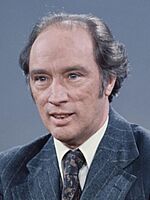
When Prime Minister Trudeau decided to retire in 1984, Chrétien ran to become the new leader of the Liberal Party. He presented himself as someone who would continue Trudeau's policies. He lost the leadership race to John Turner.
Turner then appointed Chrétien Deputy Prime Minister and Secretary of State for External Affairs. However, their relationship was difficult.
In Opposition (1984–1993)
After the Liberals lost the 1984 election to Brian Mulroney's Progressive Conservatives, Chrétien's relationship with John Turner became very strained. Chrétien left politics for a short time in 1986. He worked in the private sector, serving on the boards of several companies.
Returns to Politics and Wins Leadership
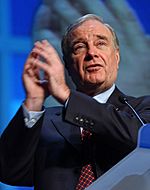
After the Liberals lost another election in 1988, Turner resigned as leader. Chrétien decided to return to politics and ran for the Liberal Party leadership again in 1990. His main opponent was Paul Martin.
A big issue during this time was the Meech Lake Accord, a plan to change the Constitution. Chrétien had a complex view on it, which caused some debate. Despite this, Chrétien won the leadership on the first ballot in June 1990.
Leader of the Official Opposition
As the new Liberal leader, Chrétien became the Leader of the Official Opposition. He strongly opposed the new Goods and Services Tax (GST) introduced by the Mulroney government. He ordered Liberal senators to try and block the GST bill, which led to much debate in Parliament.
In December 1990, Chrétien won a special election in the riding of Beauséjour in New Brunswick to get a seat in the House of Commons.
In the early 1990s, Canada was in a recession. Chrétien believed that Canada needed to increase its exports to other countries to help the economy. He also supported free trade agreements.
Chrétien supported the Charlottetown Accord in 1992, another attempt to change the Constitution. He felt that these constitutional debates were hurting Canada and that the Accord was the best way to end them.
The 1993 Election
In 1993, Prime Minister Mulroney retired, and Kim Campbell became the new Progressive Conservative leader. Chrétien led the Liberals into the 1993 election.
The Liberals released their platform, a detailed plan called the "Red Book." They promised to get rid of the GST, renegotiate the North American Free Trade Agreement (NAFTA), and invest in infrastructure projects to boost the economy. They also promised to reduce the government's deficit.
During the campaign, the Progressive Conservatives released an advertisement that seemed to make fun of Chrétien's facial paralysis. Chrétien responded strongly, saying, "God gave me a physical defect, and I accepted that since I'm a kid. It's true, that I speak on one side of my mouth. I'm not a Tory, I don't speak on both sides of my mouth." This ad caused a lot of public anger and helped Chrétien.
On October 25, 1993, the Liberals won a large majority government, taking 177 seats. The Progressive Conservatives suffered a huge defeat, winning only two seats. Chrétien won his old riding of Saint-Maurice.
Prime Minister (1993–2003)

Jean Chrétien became prime minister on November 4, 1993. He had a lot of experience in government, which helped him lead a very organized government. His government focused on managing issues as they came up.
Quebec and National Unity
1995 Quebec Referendum
A major challenge for Chrétien was the possibility of Quebec separating from Canada. In September 1995, Quebec held another independence referendum. At first, polls showed the "No" side (staying in Canada) was winning easily. However, as the campaign went on, support for the "Yes" side grew quickly.
On October 30, 1995, the "No" side won by a very small margin, with 50.58% of the vote.
After the Referendum
After the close vote, Chrétien's government started a new approach to keep Canada united. This included promoting Canada more in Quebec. In 1996, Chrétien also suggested that if Quebec were to separate, regions within Quebec that voted "No" could remain part of Canada.
In February 1996, during a public event, Chrétien was confronted by a protester. Chrétien responded by grabbing the protester by the neck. This incident became known as the "Shawinigan handshake".
Clarity Act
Following the 1995 referendum, Chrétien championed the Clarity Act. This law, passed in June 2000, states that the Canadian government will only recognize a province's declaration of independence if there is a "clear majority" vote on a "clear question" about sovereignty. This law aimed to make the rules for separation very clear.
Domestic Affairs
In November 1997, Canada hosted the Asia-Pacific Economic Cooperation (APEC) summit in Vancouver. There were protests during the meeting. Chrétien was later cleared of any wrongdoing related to how police handled the protesters.
In 1999, Chrétien advised Queen Elizabeth II not to give a British title to Canadian media owner Conrad Black. This was based on a Canadian tradition from 1917. Black sued Chrétien, but the courts ruled in Chrétien's favour.
Electoral Reforms
In July 2003, Chrétien's government passed a law to change how elections are funded. This law aimed to reduce the influence of large donations from companies and unions. It provided a subsidy to political parties based on the number of votes they received.
Social Issues
In 1995, the Chrétien government introduced the Canadian Firearms Registry, which required the registration of most firearms in Canada.
In April 2003, a new Youth Criminal Justice Act was introduced. This law changed how young people are dealt with in the justice system. The government also passed important environmental laws, including the Species at Risk Act.
In July 2003, Chrétien changed his view on gay marriage. After a court ruling in Toronto, he supported a bill to legalize same-sex marriage across Canada.
Economic Policy
Chrétien's government focused on improving Canada's finances. They worked to eliminate the large government deficit. The first budget under his government in 1994 began with modest cuts.
In 1995, the government introduced deeper spending cuts. Chrétien supported these cuts, even though they were difficult. He said it was necessary to prevent Canada from facing a financial crisis. These efforts led to Canada having a balanced budget in February 1998, for the first time since 1969.
During his time as prime minister, the government eliminated a $42 billion deficit. They also recorded five budget surpluses and paid down $36 billion in debt. Taxes were also cut. While these changes helped the economy, some government services, especially in healthcare, saw reductions.
In 1996, the Chrétien government worked to combine the federal GST with provincial sales taxes in some Atlantic provinces.
Foreign Policy
Canada in Conflicts
In 1999, Chrétien supported Canada's involvement in the North Atlantic Treaty Organization (NATO) bombing campaign in Yugoslavia over the issue of Kosovo. He also ordered Canadian military intervention in the War in Afghanistan after the September 11 attacks.
Relations with China
Chrétien was interested in the People's Republic of China. In 1994, he led the first of several "Team Canada" trade missions to China. These missions aimed to increase trade between Canada and China. Chrétien focused on economic ties, believing that trade would help improve relations.
Relations with the United States

After the September 11 attacks in 2001, Canadian forces joined a group of countries to fight al-Qaeda in Afghanistan. U.S. President George W. Bush praised Canada's response, which included Operation Yellow Ribbon to help grounded flights.
Refusal to Join the Iraq War
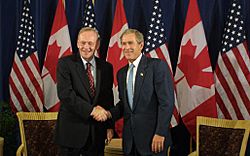
Chrétien's government did not support the US-led 2003 invasion of Iraq. His main reason was that the war did not have approval from the United Nations Security Council. To show that Canada was still a good ally, Chrétien agreed to send more Canadian troops to Afghanistan in 2003.
Defence Policy
In 1993, Chrétien cancelled a contract to buy new EH-101 helicopters for the military. This meant the search for new helicopters had to start over. Later, in 1998, his government announced that older helicopters would be replaced by a search-and-rescue version of the EH101, called the CH-149 Cormorant.
Re-elections
1997 Federal Election
Chrétien called an early election in the spring of 1997. He hoped to win another majority government. Despite some challenges, the Liberals kept a majority government, mainly due to strong support in Ontario.
2000 Federal Election
Chrétien called another early election in the fall of 2000. He aimed to take advantage of divisions among conservative parties. The Liberals won a strong majority government again, gaining more seats in Quebec and Atlantic Canada.
Scandals and Controversies
Shawinigate
In late 2000 and early 2001, there were questions about Chrétien's involvement in loans from the Business Development Bank of Canada to a hotel and golf resort in his hometown. Chrétien said he had sold his interest in the property. The police investigated but found no evidence to lay charges.
Sponsorship Scandal
A major controversy during Chrétien's later years was the Sponsorship Scandal. This involved government money given to companies in Quebec, with little accountability. In 2002, a report found that rules were broken in how some contracts were given out. Chrétien argued that the program was necessary to promote Canadian unity in Quebec. This scandal affected the Liberal Party's reputation after he left office.
Chrétien and Martin: Liberal Party Infighting
Relations between Chrétien and his finance minister, Paul Martin, were often difficult. Martin hoped to become prime minister after Chrétien. By early 2002, their rivalry became very public.
Resignation
In August 2002, Chrétien announced that he would not lead the Liberal Party in the next election. He set his resignation date for February 2004. However, due to increasing pressure from Martin's supporters, Chrétien resigned earlier. His last day as prime minister was December 12, 2003, when Paul Martin took over.
Retirement
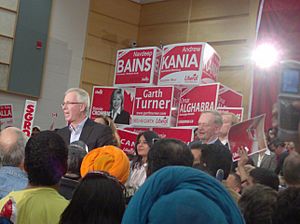
After leaving office, Jean Chrétien joined a law firm. The Sponsorship Scandal continued to be investigated, and a public inquiry, the Gomery Commission, was held. Chrétien testified at the commission in 2005. He believed the commission was unfair to him.
In October 2007, Chrétien had heart surgery but made a full recovery.
In November 2008, Chrétien helped negotiate a possible agreement between the Liberal Party, the New Democratic Party, and the Bloc Québécois to form a new government.
In August 2010, Chrétien had emergency brain surgery but recovered quickly.
Chrétien has continued to be involved in public life. He is a member of the Club de Madrid, a group of former democratic leaders. He was also appointed to the Order of Canada and the Order of Merit by Queen Elizabeth II.
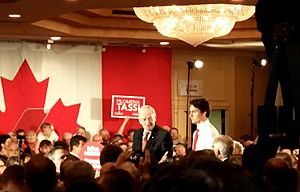
In 2015, Chrétien wrote an open letter criticizing the government's response to the European migrant crisis. He urged Canadians to vote for a change in government.
In September 2022, Chrétien attended Queen Elizabeth II's state funeral.
Legacy
Jean Chrétien is often ranked highly among Canadian prime ministers by historians and scholars. He is remembered for improving Canada's finances and for his efforts to keep the country united. Many also remember his decision not to join the Iraq War.
Supreme Court Appointments
During his time as prime minister, Chrétien appointed the following judges to the Supreme Court of Canada:
- Michel Bastarache (1997)
- William Ian Corneil Binnie (1998)
- Louise Arbour (1999)
- Louis LeBel (2000)
- Beverly McLachlin (as chief justice, 2000)
- Marie Deschamps (2002)
- Morris J. Fish (2003)
Honours
| Ribbon | Description | Notes |
| Order of Merit (O.M.) |
|
|
| Companion of the Order of Canada (C.C.) |
|
|
| Centennial Anniversary of the Confederation of Canada Medal |
|
|
| Queen Elizabeth II Silver Jubilee Medal for Canada |
|
|
| 125th Anniversary of the Confederation of Canada Medal |
|
|
| Queen Elizabeth II Golden Jubilee Medal for Canada |
|
|
| Queen Elizabeth II Diamond Jubilee Medal for Canada |
|
|
| Order of Friendship from the Russian Federation |
|
|
| Grand Cordon of the Order of the Rising Sun from the Japanese government |
|
Honorary Degrees
Jean Chrétien has received many honorary degrees from universities around the world. These degrees recognize his achievements and contributions.
| Location | Date | School | Degree |
|---|---|---|---|
| 1981 | Wilfrid Laurier University | Doctor of Laws (LL.D) | |
| 1982 | Laurentian University | Doctor of Laws (LL.D) | |
| 1986 | York University | Doctor of Laws (LL.D) | |
| 1987 | University of Alberta | Doctor of Laws (LL.D) | |
| 1988 | Lakehead University | Doctor of Laws (LL.D) | |
| 1994 | University of Ottawa | Doctor of the University (D.Univ) | |
| 1994 | University of Moncton | ||
| 1996 | Meiji University | Doctorate | |
| 1999 | Warsaw School of Economics | Doctorate | |
| 1999 | Michigan State University | Doctor of Laws (LL.D) | |
| 2000 | Hebrew University of Jerusalem | ||
| 2000 | Memorial University of Newfoundland | Doctor of Laws (LL.D) | |
| 2003 | Pontificia Universidad Católica Madre y Maestra | ||
| 2004 | Queen's University | Doctor of Laws (LL.D) | |
| 2005 | McMaster University | Doctor of Laws (LL.D) | |
| 2007 | National University of Kyiv-Mohyla Academy | ||
| October 23, 2008 | University of Western Ontario | Doctor of Laws (LL.D) | |
| 2008 | Université du Québec à Trois-Rivières | ||
| June 2010 | Concordia University | Doctor of Laws (LL.D) | |
| 2011 | Université de Montréal | ||
| June 12, 2014 | University of Winnipeg | Doctor of Laws (LL.D) | |
| 2022 | Carleton University | Doctor of Laws (LL.D) |
See also
 In Spanish: Jean Chrétien para niños
In Spanish: Jean Chrétien para niños
- List of prime ministers of Canada
Succession
| Parliament of Canada | ||
|---|---|---|
| Preceded by Herb Gray |
Leader of the Official Opposition 1990–1993 |
Succeeded by Lucien Bouchard |
| Preceded by ' |
Deputy Leader of the Official Opposition 1984–1986 |
Succeeded by |
| Preceded by Gérard Lamy |
Member for Saint-Maurice—Laflèche 1963–1968 |
District abolished |
| New district | Member for Saint-Maurice 1968–1986 |
Succeeded by Gilles Grondin |
| Preceded by Fernand Robichaud |
Member for Beauséjour 1990–1993 |
Succeeded by Fernand Robichaud |
| Preceded by Denis Pronovost |
Member for Saint-Maurice 1993–2003 |
District abolished |
| Party political offices | ||
| Preceded by John Turner |
Leader of the Liberal Party 1990–2003 |
Succeeded by Paul Martin |
| Preceded by Allan MacEachen |
Deputy Leader of the Liberal Party 1984–1986 |
Succeeded by |
| 26th Ministry – Cabinet of Jean Chrétien | ||
| Cabinet post (1) | ||
| Predecessor | Office | Successor |
| Kim Campbell | Prime Minister of Canada 1993–2003 |
Paul Martin |
| 23rd Ministry – Cabinet of John Turner | ||
| Cabinet posts (2) | ||
| Predecessor | Office | Successor |
| Allan MacEachen | Deputy Prime Minister of Canada 1984 |
Erik Nielsen |
| Allan MacEachen | Secretary of State for External Affairs 1984 |
Joe Clark |
| 22nd Ministry – Second cabinet of Pierre Trudeau | ||
| Cabinet posts (2) | ||
| Predecessor | Office | Successor |
| Marc Lalonde | Minister of Energy, Mines and Resources 1982–1984 |
Gerald Regan |
| Jacques Flynn | Minister of Justice 1980–1982 |
Mark MacGuigan |
| 20th Ministry – First cabinet of Pierre Trudeau | ||
| Cabinet posts (5) | ||
| Predecessor | Office | Successor |
| Donald Stovel Macdonald | Minister of Finance 1977–1979 |
John Crosbie |
| Don Jamieson | Minister of Industry, Trade and Commerce 1976–1977 |
Jack Horner |
| Charles Drury | President of the Treasury Board 1974–1976 |
Bob Andras |
| Arthur Laing | Minister of Indian Affairs and Northern Development 1968–1974 |
Judd Buchanan |
| cont'd from 19th Min. | Minister of National Revenue 1968 |
Jean-Pierre Côté |
| 19th Ministry – Cabinet of Lester B. Pearson | ||
| Cabinet posts (2) | ||
| Predecessor | Office | Successor |
| Edgar Benson | Minister of National Revenue 1968 |
cont'd into 20th Min. |
| Minister without Portfolio 1967–1968 |
||
| Political offices | ||
| Preceded by Silvio Berlusconi |
Chairperson of the G7 1995 |
Succeeded by Jacques Chirac |
| Preceded by Fidel Ramos |
Chairperson of APEC 1997 |
Succeeded by Mahathir Mohamad |
| Preceded by Silvio Berlusconi |
Chairperson of the G8 2002 |
Succeeded by Jacques Chirac |
| Order of precedence | ||
| Preceded by Kim Campbell |
Canadian order of precedence as of 2010[update] |
Succeeded by Paul Martin |


